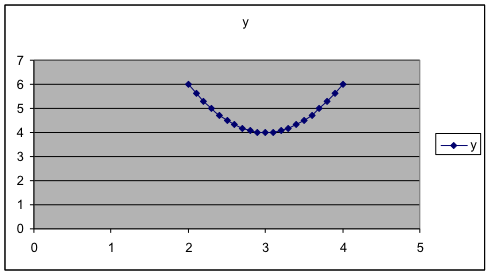24.7: E1.06- Graphs Part 2
- Page ID
- 51749
Example 9. Just by sketching some more of the graph, estimate the y-value of when
.
Solution: Extend the graph a bit and find that it appears to give .
Check: Check this by plugging into the formula,
Example 10. Use the graph to estimate which x gives the lowest value for y when on the values
.
Solution: That x-value is clearly between 0 and 5. It appears to be a bit above halfway. So we estimate that it is about .
Example 11. Let’s “magnify” the portion of the graph near in order to see very precisely where the minimum value is. Actually, we leave the old dataset and graph alone and produce a new one. This time, we’ll just use x values near 3. So we’ll graph
on the values
where we increase the x-values in increments of 0.1. Use the same technique as before. Here is the middle part of the data table and the graph. This makes clear that
gives the minimum value for y.
|  |
Check: To see that this is right, plug in and find the y-value. Then plug in a couple of other x-values close by and see if their y-values are lower or higher.
So and then
Now and then
Now and then
These make it clear that the value of y at is smaller than the value of y at values for x near 3. Putting that together with what we saw on the graph, it is very clear now that is the correct answer.
Example 12. Optional: Changing the titles, labels, and scale along the axes.
In Example 4, we might prefer to have a graph with more labels, more grid lines, and different scales for the axes. Here is the result we want and how to obtain it in Excel. This may be done differently or may not be possible in other spreadsheet programs.
- Mathematics for Modeling. Authored by: Mary Parker and Hunter Ellinger. License: CC BY: Attribution


